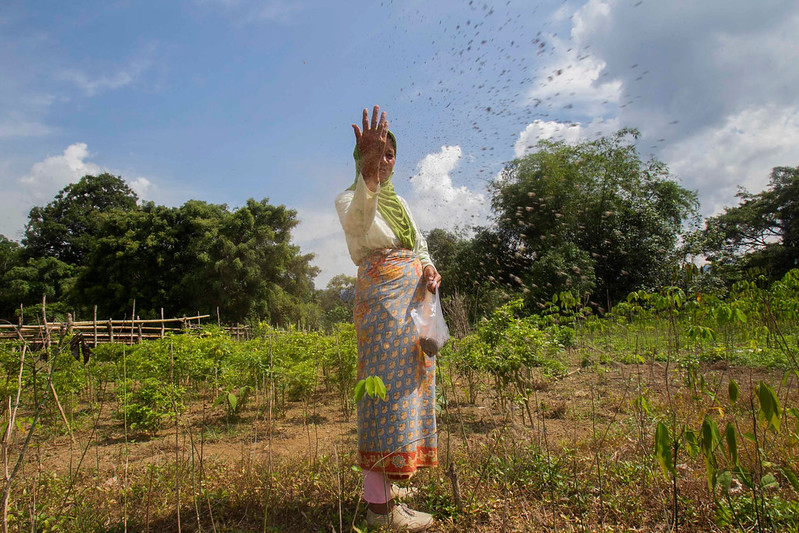Getting villages on board is a key challenge for tackling climate change in Indonesia
Since 2015, the government has been distributing funds to villages to boost the country’s economic development. But the money is often spent on infrastructure projects instead of climate-related works.
I
n 2015, Southeast Asia’s largest economy, Indonesia, committed to reducing greenhouse gas emissions by 29% by 2030 (equivalent to 832.01 million tonnes of CO2 by 2030, compared to what it was then on course for.
It said it was prepared to go up to 41% with support from international donors. According to a recent government report, Indonesia needs US$247 billion to meet this target.
To achieve its emissions target, the government needs public support and participation. One way to do this is by appealing to the smallest administrations, villages, through the Village Fund.
Since 2015, the government has been distributing funds to villages to boost the country’s economic development.
Called the Village Fund, this has grown from Rp122 million (US$8,896) for each village in 2015, to Rp1.5 billion (US$107,492.30) in 2019.
However, the majority of villages in Indonesia have been using the money to build infrastructure and provide health and education facilities.
A study of more than 38 villages in Southeast Sulawesi, shows 30 villages preferred spending village funds on infrastructure projects in 2017. All 38 villages surveyed spent the village fund on infrastructure in 2015.
The major reason for this was their lack of understanding on climate change.
Villagers believe building bridges will bring more economic benefits than saving the environment.
But they should be aware some villages can also profit from spending the fund on environmental projects.

Agroforestry in Lubuk Beringin village, Indonesia. Source: CIFOR/Flickr
Major challenges
Villagers believe taking care of the environment is not a priority and issues like education and health are more important.
Local communities also do not understand how to spend the Village Fund, so infrastructure seems to be the most obvious option.
This limited understanding is further exacerbated by the absence of technical assistance provided to the villages.
Only 42% of the total 38 villages said they received technical assistance for preparing and implementing activities associated with the Village Fund.
The remaining 58% of respondents reported they did not have any technical assistance whatsoever related to the Village Fund.
The study recommend the government provide technical assistance or facilitators to villagers, so they can understand climate change and implement activities to mitigate and adapt to it.
The government should provide facilitators who can provide communities with information on what activities they can choose to adapt to, or mitigate, climate change.
The facilitators should inform villagers on the impacts of the changing climate and how they can mitigate risks.
For instance, they can inform farmers about the risks of crop failure. The farmers can prevent these by diversifying crops.
New regulation
In an attempt to involve villagers in saving the environment, the government issued a decree in 2018, which allowed them to spend their funds for climate mitigation and environmental protection.
Under the new decree, local administrations can also spend the fund to combat illegal logging, establish renewable energy sources, build irrigation or drainage systems, move to climate resilient seedling, access climate information and conserve water springs.
These programs are in line with the Indonesian government’s efforts to reduce greenhouse gas emissions.
Not only do they save the environment, the programs can also bring economic benefit to villagers.
Unfortunately, this regulation has yet to bring effects because of lack of information dissemination and promotion in villages.
Moving forward
This new regulation can earmark a portion of the Village Fund for climate action. This can help speed up programs to curb greenhouse gas emissions.
Between 2008 and 2012, the government created an earmarked fund to finance environmental activities at the village level as a subset of the PNPM (village development) program. The program was the predecessor of Village Fund.
The fund was disbursed together with strong technical assistance to eight pilot provinces, including Southeast Sulawesi.
An example from Balunganyar village in Pasuruan, East Java province, shows how their environmental program helps villagers save money for cooking expenses.
Using the Village Fund, the Balunganyar administration established a biogas installation to generate gas for cooking from cattle dung. Five houses can use one installation, which costs around Rp22 million (US$1,567).
Communities do not need to purchase gas for cooking anymore and only have to pay Rp7,500 or US$0.50 for maintenance. With the installation, communities no longer dump the dung into the river which in turn has reduced pollution.
The study suggests that this success story should be replicated across other villages in Indonesia.
Moreover, the government should allocate a portion of the budget to provide technical support to villagers so they can design and implement environmental programs.
The ideas presented in this article aim to inspire adaptation action – they are the views of the author and do not necessarily reflect those of the Global Center on Adaptation.